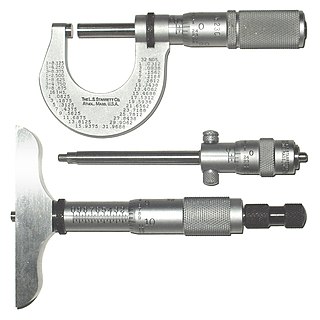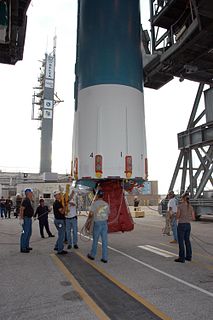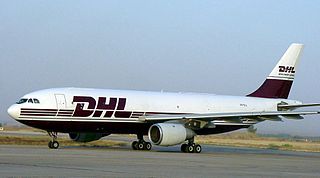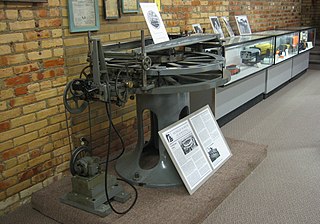
A micrometer, sometimes known as a micrometer screw gauge, is a device incorporating a calibrated screw widely used for accurate measurement of components in mechanical engineering and machining as well as most mechanical trades, along with other metrological instruments such as dial, vernier, and digital calipers. Micrometers are usually, but not always, in the form of calipers. The spindle is a very accurately machined screw and the object to be measured is placed between the spindle and the anvil. The spindle is moved by turning the ratchet knob or thimble until the object to be measured is lightly touched by both the spindle and the anvil.

A carburetor or carburettor is a device that mixes air and fuel for internal combustion engines in the proper air–fuel ratio for combustion. It is sometimes colloquially shortened to carb in the UK and North America or carby in Australia. To carburate or carburet means to mix the air and fuel or to equip with a carburetor for that purpose.

The Surveyor program was a NASA program that, from June 1966 through January 1968, sent seven robotic spacecraft to the surface of the Moon. Its primary goal was to demonstrate the feasibility of soft landings on the Moon. The Surveyor craft were the first American spacecraft to achieve soft landing on an extraterrestrial body. The missions called for the craft to travel directly to the Moon on an impact trajectory, a journey that lasted 63 to 65 hours, and ended with a deceleration of just over three minutes to a soft landing. The program was implemented by NASA's Jet Propulsion Laboratory (JPL) to prepare for the Apollo program. JPL selected Hughes Aircraft to develop the spacecraft system. The total cost of the Surveyor program was officially $469 million.

A model aircraft is a small sized unmanned aircraft or, in the case of a scale model, a replica of an existing or imaginary aircraft. Model aircraft are divided into two basic groups: flying and non-flying. Non-flying models are also termed static, display, or shelf models.
Throttle is any mechanism by which the power or speed of an engine is controlled.
A governor, or speed limiter or controller, is a device used to measure and regulate the speed of a machine, such as an engine.

A protractor is a measuring instrument, typically made of transparent plastic or glass, for measuring angles. Most protractors measure angles in
degrees (°). Radian-scale protractors measure angles in radians. Most protractors are divided into 180 equal parts. Some precision protractors further divide degrees into arcminutes.

A radio-controlled aircraft is a small flying machine that is controlled remotely by an operator on the ground using a hand-held radio transmitter. The transmitter communicates with a receiver within the craft that sends signals to servomechanisms (servos) which move the control surfaces based on the position of joysticks on the transmitter. The control surfaces, in turn, affect the orientation of the plane.

A caliper is a device used to measure the distance between two opposite sides of an object. Many types of calipers permit reading out a measurement on a ruled scale, a dial, or a digital display. But a caliper can be as simple as a compass with inward or outward-facing points. The tips of the caliper are adjusted to fit across the points to be measured and then the caliper is then removed and the distance read by measuring between the tips with a measuring tool, such as a ruler.

A Radio-controlled helicopter is model aircraft which is distinct from a RC airplane because of the differences in construction, aerodynamics, and flight training. Several basic designs of RC helicopters exist, of which some are more maneuverable than others. The more maneuverable designs are often harder to fly, but benefit from greater aerobatic capabilities.

The RS-27A is a liquid-fuel rocket engine developed in 1980s by Rocketdyne for use on the first stage of the Delta II and Delta III launch vehicles. It provides 1.05 meganewtons (240,000 lbf) of thrust burning RP-1 and LOX in a gas-generator cycle. The engine is a modified version of its predecessor, the RS-27; its thrust nozzle has been extended to increase its area ratio from 8:1 to 12:1, which provides greater efficiency at altitude. The earlier RS-27 was derived from surplus Rocketdyne H-1 engines used in the Saturn 1B launcher.

On 22 November 2003, shortly after takeoff from Baghdad, Iraq, an Airbus A300B4-200F cargo plane, registered OO-DLL and owned by European Air Transport was struck on the left wing tip by a surface-to-air missile while on a scheduled flight to Muharraq, Bahrain. Severe wing damage resulted in a fire and complete loss of hydraulic flight control systems. Because outboard left wing fuel tank 1A was full at takeoff, there was no fuel-air vapour explosion. Liquid jet fuel dropped away as 1A disintegrated. Inboard fuel tank 1 was pierced and leaking.

A vernier thruster is a rocket engine used on a spacecraft for fine adjustments to the attitude or velocity of a spacecraft. Depending on the design of a craft's maneuvering and stability systems, it may simply be a smaller thruster complementing the main propulsion system, or it may complement larger attitude control thrusters, or may be a part of the reaction control system.
The name is derived from vernier calipers which have a primary scale for gross measurements, and a secondary scale for fine measurements.
In metrology, the least count of a measuring instrument is the smallest change in the measured quantity that can be resolved on the instrument's scale. The least count is related to the precision of an instrument; an instrument that can measure smaller changes in a value relative to another instrument, has a smaller "least count" value and so is more precise. Any measurement made by the instrument can be considered repeatable to no less than the resolution of the least count. The least count of an instrument is inversely proportional to the precision of the instrument.

A supercharger is an air compressor that increases the pressure or density of air supplied to an internal combustion engine. This gives each intake cycle of the engine more oxygen, letting it burn more fuel and do more work, thus increasing power.

A dividing engine is a device employed to mark graduations on measuring instruments to allow for reading smaller measurements than can be allowed by directly engraving them. The well-known Vernier scale and Micrometer screw-gauge are classic examples that make use of such graduations.

Thrust levers or power levers are found in the cockpit of aircraft, and are used by the pilot, copilot, or autopilot to control the thrust output of the aircraft's engines.















